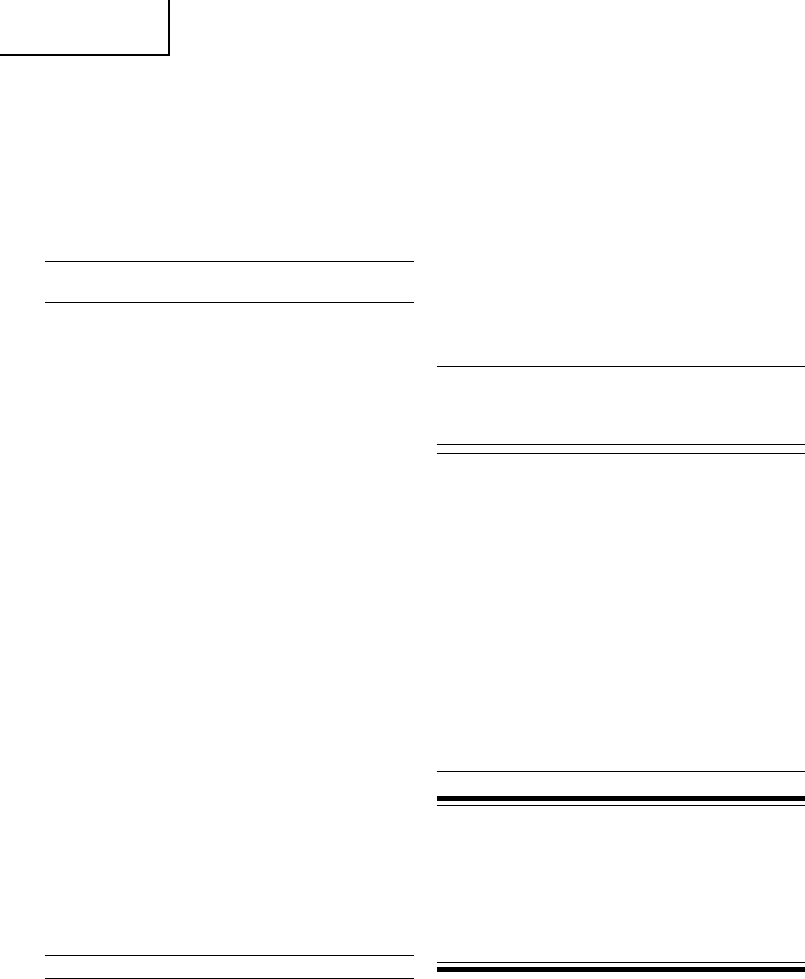
6
English
3. Moving the circular saw straight with an appropriate
speed will result in optimum cutting.
CAUTIONS
⅜ Before starting cutting operation, ensure that the
saw blade has reached full speed revolution.
⅜ Should the saw blade stop or makes an abnormal
noise during operation, turn off the switch
immediately.
⅜ Always take care in preventing the power cord from
coming near the revolving saw blade.
MOUNTING AND DISMOUNTING
THE SAW BLADE
CAUTION
To avoid serious accident, ensure the switch is in the OFF
position, and the plug is disconnected from the power
receptacle.
1. Dismounting the saw blade
(1) Set the cutting depth at maximum, and place the
Circular Saw as shown in Fig. 7.
(2) Depress the lock lever to lock the spindle, and
remove the hexagon head bolt with the provided
wrench by turning it counterclockwise.
(3) While holding the safely cover lever to keep it fully
retracted into the saw cover, remove the saw blade.
2. Mounting the Saw Blade:
(1) Thoroughly remove any sawdust which has
accumulated on the spindle, bolt and washers.
(2) The inside diameter of the saw blade differs according
to the market area the circular saw is sold in.
(a) For mounting saw blade of 25 mm inner
diameters (Fig. 8 (a)), mount the saw blade to
washer (A) whose size is identical with the saw
blade inner diameter, and the concave side of
washer (B) faces the saw blade.
(b) In the case of a saw blade of 30 mm inner
diameter (Fig. 8 (b)), mount the adapter ring to
washer (A) whose size is identical with the
adapter ring inner diameter and mount the saw
blade on the adapter ring, and the concave side
of washer (B)) faces the saw blade.
(3) To check proper rotation direction of the saw blade,
the arrow direction on the saw blade must coincide
with the arrow direction embossed on the saw
cover.
(4) Using the fingers, tighten the hexagon head bolt
retaining the saw blade as much as possible. Then
depress the lock lever, lock the spindle, and securely
tighten the bolt.
CAUTION
On completion of mounting the saw blade, reconfirm that
the lock lever is firmly resumed in the original position.
MAINTENANCE AND INSPECTION
1. Inspecting the saw blade:
Since use of a dull saw blade will degrade efficiency
and cause possible motor malfunction, resharpen
or replace the saw blade as soon as abrasion is
noted.
2. Inspecting the mounting screws:
Regularly inspect all mounting screws and ensure
that they are properly tightened. Should any of the
screws be loosened, retighten them immediately.
Failure to do so could result in serious hazard.
3. Inspecting the carbon brushes (Fig. 9)
The motor employs carbon brushes which are
consumable parts. Since an excessively worn carbon
brushes can result in motor trouble, replace the
carbon brushes with new ones having the same
carbon brush No. shown in the figure when they
become worn to or near the “wear limit”. In addition,
always keep carbon brushes clean and ensure that
they slide freely within the brush holders.
4. Replacing a carbon brushes:
Disassemble the brush caps with a screw-driver.
The carbon brushes can then be easily removed.
5. Maintenance of the motor
The motor unit winding is the very “heart” of the
power tool.
Exercise due care to ensure the winding does not
become damaged and/or wet with oil or water.
NOTE
Due to HITACHI’s continuing program of research and
development, the specifications herein are subject to
change without prior notice.
IMPORTANT
Correct connection of the plug
The wires of the mains lead are coloured in accordance
with the following code:
Blue: -Neutral
Brown: -Live
As the colours of the wires in the mains lead of this tool
may not correspond with the coloured markings
identifying the terminals in your plug proceed as follows:
The wire coloured blue must be connected to the terminal
marked with the letter N or coloured black.
The wire coloured brown must be connected to the
terminal marked with the letter L or coloured red.
Neither core must be connected to the earth terminal.
NOTE
This requirement is provided according to BRITISH
STANDARD 2769: 1984.
Therefore, the letter code and colour code may not be
applicable to other markets except the United Kingdom.
Information concerning airborne noise and vibration
The measured values were determined according to
EN50144.
The typical A-weighted sound pressure level: 91 dB (A).
The typical A-weighted sound power level: 104 dB (A)
Wear ear protection.
The typical weighted root mean square acceleration value
does not exceed 2.5 m/s
2
.


















